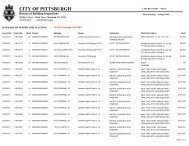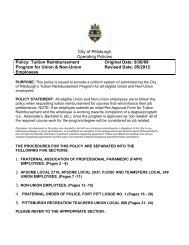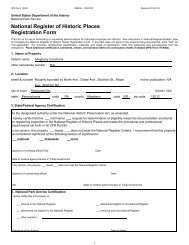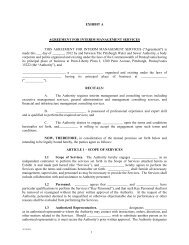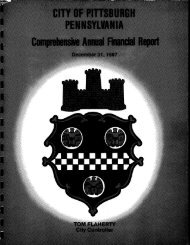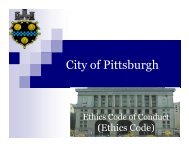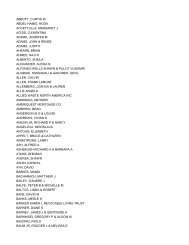east liberty station: realizing the potential - City of Pittsburgh
east liberty station: realizing the potential - City of Pittsburgh
east liberty station: realizing the potential - City of Pittsburgh
You also want an ePaper? Increase the reach of your titles
YUMPU automatically turns print PDFs into web optimized ePapers that Google loves.
Long-term: Roundabout at Penn<br />
Avenue and Shady Avenue<br />
78<br />
Modern roundabouts in both <strong>the</strong> United<br />
States and o<strong>the</strong>r countries have achieved<br />
a 50 to 90 percent reduction in collisions<br />
compared with intersections using traffic<br />
signals. Studies have found a particularly<br />
significant reduction (up to 90%) in<br />
<strong>the</strong> number <strong>of</strong> crashes that result in<br />
death or disability, in good part because<br />
roundabouts eliminate <strong>the</strong> high-speed,<br />
severe angle crashes (such as T-bone and<br />
head-on crashes) which occur at traffic<br />
signals. In addition, <strong>the</strong> high capacity <strong>of</strong><br />
<strong>the</strong> roundabouts is what makes it possible<br />
to remove lanes between intersections.<br />
This can <strong>potential</strong>ly allow for <strong>the</strong> addition<br />
<strong>of</strong> bicycle lanes in lieu <strong>of</strong> <strong>the</strong> underutilized<br />
travel lanes.<br />
Properly designed roundabouts provide<br />
large safety benefits for pedestrians, when<br />
compared to intersections controlled by<br />
ei<strong>the</strong>r stop signs or traffic signals. For<br />
example, a Dutch study <strong>of</strong> 181 intersections<br />
that were converted to roundabouts found<br />
an 89 percent reduction in casualties<br />
(fatalities and injuries). O<strong>the</strong>r studies<br />
have also found major improvements in<br />
pedestrian safety. This reduction in crashes<br />
occurs because roundabouts provide three<br />
key features that pedestrians need for a<br />
safe crossing: simple decision-making, short<br />
crossing distances, and low traffic speeds.<br />
Decision-making is simple because<br />
pedestrians cross one direction <strong>of</strong> traffic<br />
at a time, traveling from curb to splitter<br />
island, <strong>the</strong>n from splitter island to curb.<br />
Vehicle speeds are kept low by <strong>the</strong> physical<br />
constraints <strong>of</strong> <strong>the</strong> roundabout. On one<br />
side, pedestrians cross behind drivers who<br />
are waiting to enter <strong>the</strong> roundabout. On<br />
<strong>the</strong> o<strong>the</strong>r, drivers exiting <strong>the</strong> roundabout<br />
at low speed have room to pause outside<br />
<strong>the</strong> circle, while pedestrians cross <strong>the</strong><br />
13 feet from splitter-island to curb. By<br />
contrast, crossing Penn Avenue at a signal,<br />
pedestrians face conflicts from both rightturning<br />
and left-turning drivers who also<br />
have a green light, and also are at risk from<br />
drivers making a right-turn on red. All <strong>of</strong><br />
<strong>the</strong>se drivers at signals are simultaneously<br />
searching for gaps in traffic. Because<br />
roundabouts reduce <strong>the</strong> large number<br />
<strong>of</strong> conflicts found at signals, <strong>the</strong>y are<br />
able to provide safety improvements for<br />
pedestrians.<br />
Roundabouts also slow traffic, and<br />
are particularly useful in areas where<br />
drivers should recognize <strong>the</strong> presence <strong>of</strong><br />
pedestrians. They can also serve as an<br />
attractive gateway to a community. As<br />
East Liberty develops land adjacent to <strong>the</strong><br />
busway <strong>station</strong>, a more visible transit node<br />
will emerge which can be greatly enhanced<br />
by gateway treatments in <strong>the</strong> center <strong>of</strong> <strong>the</strong><br />
roundabout.<br />
Based on forecasted traffic volumes<br />
developed for <strong>the</strong> Eastside Development<br />
project, a roundabout that could work<br />
at <strong>the</strong> Penn Avenue/Shady Avenue<br />
intersection is shown in <strong>the</strong> above diagram.<br />
A conceptual illustration <strong>of</strong> this roundabout<br />
superimposed onto <strong>the</strong> <strong>station</strong> area<br />
plan is shown at right. This roundabout<br />
would need to be approximately 180 feet



